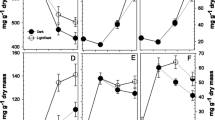Abstract
Seed clusters of individual locules from fruit capsules of Gossypium arboreum L. with adhering intact fibres were fed with radioactive uridinediphosphoglucose (UDPG), guanosinediphosphoglucose (GDPG), glucose and sucrose. The incorporation into high molecular weight glucans of the fibres was studied. For primary wall fibres, UDPG at 1 mM was by far the best precursor, whereas sucrose was the best precursor for secondary wall fibres. No competition was observed between the incorporation of glucose from UDPG and from sucrose when the two were fed simultaneously to secondary wall fibres, indicating that their metabolic pathways are well separated when they are fed from the apoplast. Inhibitors of respiratory ATP-formation strongly inhibited incorporation of sucrose but not that of UDPG. Sucrose incorporation was studied at five different stages of development of the cotton fibres. At the stage of most intense secondary wall formation the incorporation rate was about 300 times that during primary wall formation (24 days post anthesis (DPA)). Incorporation from 1 mM UDPG or GDPG by secondary wall fibres (35 DPA) was less than twice that of primary wall fibres (22 DPA), indicating that the two sugar nucleotides are not readily used as precursors for secondary wall cellulose when they are fed to the exterior of intact cells. The high molecular weight non-cellulosic glucans formed from UDPG and sucrose at 5 and 1,000 μM were solubilized in strongly alkaline solutions or dimethyl-sulfoxide (DMSO) and were partially characterized by degradation with an exo-β-1,3-glucanase. After feeding for one hour, at most 1/3 of the radioactivity in high molecular weight material was found in cellulose and at least 2/3 in β-1,3-glucan. The proportions varied little for fibres in the age range of 30 to 48 DPA when sucrose was the precursor although the total incorporation varied by a factor of about four. The fact that at all stages of secondary wall formation β-1,3-glucan is synthesized at a very high rate, but that the total amount in the cell wall does not exceed 2% in the later stages of wall formation, can be interpreted in terms of a high turnover of this polysaccharide if it is assumed that wound effects are negligible in the system under study.
Similar content being viewed by others
Abbreviations
- UDPG:
-
uridinediphosphoglucose
- GDPG:
-
guanosinediphosphoglucose
- HEPES:
-
N-2-hydroxyethylpiperazine-N′-2-ethansulphonic acid
- DMSO:
-
dimethyl-sulfoxide
- DNP:
-
2,4-dinitrophenol
- DPA:
-
days post anthesis
References
Anderson, R.L., Ray, P.M. (1978) Labeling of the plasma membrane of pea cells by a surface-localized glucan synthetase. Plant Physiol. 61, 723–730
Barber, G.A., Elbein, A.D., Hassid, W.Z. (1964) The synthesis of cellulose by enzyme systems from higher plants. J. Biol. Chem. 239, 4056–4061
Brett, C.T. (1978) Synthesis of β-(1→3)-glucan from extracellular uridine diphosphate glucose as a wound response in suspension-cultured soybean cells. Plant Physiol. 62, 377–382
Brummond, D.O., Gibbons, A.P. (1965) Enzymatic cellulose synthesis from UDP-[14C]-glucose by Lupinus albus Biochem. Z. 342, 308–318
Chao, H.Y., Maclachlan, G.A. (1978) Soluble factors in Pisum extracts which moderate Pisum β-glucan synthetase activity. Plant Physiol. 61, 943–948
Clark, A.F., Villemez, C.L. (1972) The formation of β-1,4-glucan from UDP-α-d-glucose catalyzed by a Phaseolus aureus enzyme. Plant Physiol 50, 371–374
Delmer, D.P., Heiniger, U., Kulow, C. (1977) UDP-glucose: glucan synthetase in developing cotton fibers. Plant Physiol. 59, 713–718
Feingold, D.S., Neufeld, E.F., Hassid, W.Z. (1958) Synthesis of a β-1,3-linked glucan by extracts of Phaseolus aureus seedlings. J. Biol. Chem. 233 783–788
Flowers, H.M., Batra, K.K., Kemp, J., Hassid, W.Z. (1968) Biosynthesis of insoluble glucans from uridine-diphosphate-d-glucose with enzyme preparations from Phaseolus aureus and Lupinus albus. Plant Physiol. 43, 1703–1709
Helsper, P.F.G., Veerkamp, J.H., Sassen, M.M.A. (1977) Glucan synthetase activity in golgi vesicles of Petunia hybrida. Planta 133, 303–308
Huotari, F.I., Nelson, T.E., Smith, F., Kirkwood, S. (1968) Purification of an exo-β-d-(1→3)-glucanase from Basidiomycete species QM 806. J. Biol. Chem. 243, 952–956
Huwyler, H.R., Franz, G., Meier, H. (1978) β-1,3-Glucans in the cell walls of cotton fibres (Gossypium arboreum L.) Plant Sci. Lett. 12, 55–62
Huwyler, H.R., Franz, G., Meier, H. (1979) Changes in the composition of cotton fibre cell walls during development. Planta 146, 635–642
Maltby, D., Carpita, N.C., Montezinos, D., Kulow, C., Delmer, D.P. (1979) β-1,3-Glucan in developing cotton fibers. Plant Physiol. 63, 1158–1164
Ordin, L., Hall, M.A. (1968) Cellulose synthesis in higher plants from UDP-glucose. Plant Physiol. 43, 473–476
Péaud-Lenoël, C., Axelos, M. (1970) Structural features of the β-glucans enzymatically synthesized from uridine diphosphate glucose by wheat seedlings. FEBS Lett. 8, 224–228
Raymond, Y., Fincher, G.B., MacLachlan, G.A. (1978) Tissue slice and particulate β-glucan synthetase activities from Pisum epicotyls. Plant Physiol. 61, 938–942
Reese, E.T., Mandels, M. (1959) β-d-glucanases in fungi. Can. J. Microbiol. 5, 173–185
Saeman, J.F., Moore, W.E., Mitchell, R.I., Millett, M.A. (1954) Techniques for the determination of pulp constituents by quantitative paper chromatography. Tappi 37, 336–343
Shore, G., Raymond, Y., MacLachlan, G.A. (1975) The site of cellulose synthesis. Plant Physiol. 56, 34–38
Smith, M.M., Stone, B.A. (1973) β-Glucan synthesis by cell-free extracts from Lolium multiflorum endosperm. Biochim. Biophys. Acta 313, 72–94
Stahl, E. (1969) Thin-layer chromatography. Springer: New York
Trevelyan, W.E., Procter, D.P., Harrison, J.S. (1950) Detection of sugars on paper chromatograms. Nature (London) 166, 444–445
Villemez, C.L., Franz, G., Hassid, W.Z. (1967) Biosynthesis of alkali insoluble polysaccharide from UDP-d-glucose with particulate enzyme preparations from Phaseolus aureus. Plant Physiol. 42, 1219–1223
Van der Woude, W.J., Lembi, C.A., Morré, D.J., Kindinger, J.I., Ordin, L. (1974) β-Glucan synthetases of plasma membrane and golgi apparatus from onion stem. Plant Physiol. 54, 333–340
Author information
Authors and Affiliations
Rights and permissions
About this article
Cite this article
Pillonel, C., Buchala, A.J. & Meier, H. Glucan synthesis by intact cotton fibres fed with different precursors at the stages of primary and secondary wall formation. Planta 149, 306–312 (1980). https://doi.org/10.1007/BF00384571
Received:
Accepted:
Issue Date:
DOI: https://doi.org/10.1007/BF00384571




